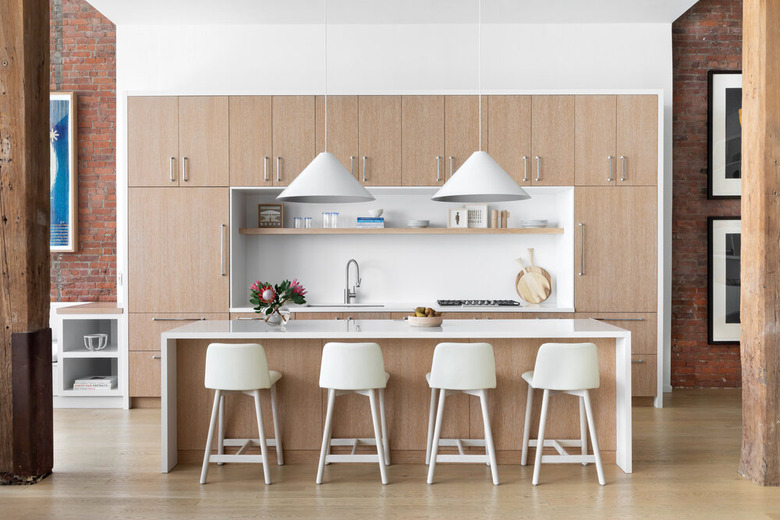Polar Opposites: Minimalism Vs. Maximalism And Why The Two Styles Are So Popular
We may receive a commission on purchases made from links.
No two styles divide decor lovers so intensely as minimalism and maximalism. Some of us love bold patterns, vivid hues, and statement furniture. Others can't stand so much color and prefer neutral palettes — or even rooms with zero color — pared-down decor, and simple furnishings.
If you don't quite know what group you fit in to, let's start with the major differences that separate minimalism versus maximalism.
What is Minimalism?
What is Minimalism?
First things first: Minimalism derived its name primarily from the 1950s American art genre, which was all about "truth, order, simplicity, and harmony," according to the Tate. Other influences include the Bauhaus movement, which included austere and simplified architecture. The style remained popular through the 1990s and recently we've seen a resurgence in it. Take for instance, the wildly popular Tidying Up With Marie Kondo which lends itself to the style's values — throw away whatever doesn't spark joy and keep only the rest.
Minimalism, versus maximalism, is all about less clutter and more purposeful decor. Celebs, of course, love the style, too. Kanye West and Kim Kardashian West's home makes clear use of minimalism, and also incorporates the characteristics of wabi-sabi. The Japanese aesthetic and philosophy is all about embracing imperfection. In decor, you often see it used to describe simple, clean spaces (also described as Japanese minimalism). There's also Scandinavian minimalism, which makes use of light wood, crisp lines, and modern graphic elements.
You can incorporate minimalism into any home size, even small-space apartments, to create a visually pleasing and relaxing space. We've seen everything from minimalist bathrooms to relaxing living rooms that incorporate the aesthetic in seriously chic ways. You can even try the style in unexpected spaces, like kids bedrooms.
What is Maximalism?
What is Maximalism?
If you're thinking "ugh, boring" then you might be on the other side of the minimalism versus maximalism argument. Maximalism comes up again and again, depending on how you might qualify it. For example, styles like 18th century Rococo (also known as Late Baroque) were super ornamental and lavish. The aesthetic is a precursor to our modern penchant for over-the-top and bold visuals in interior design. Fast forward to more modern eras and you can definitely find some overlap. In the mid-1920s, art deco started to really make its name known. The style features jewel tones, geometric patterns, sophisticated curves, and metallic accents. Though not entirely defined as a maximalist aesthetic, it would definitely feel a little too over-the-top for the dedicated minimalist.
Dorothy Draper's 1939 book Decorating is Fun! ushered in a focus on Hollywood Regency, which was all about glitzy elements like lavish chandeliers, satin upholstery, and gold accents. Draper's approach aligns pretty closely with maximalism style today — think palm leaf prints and bright lacquer furniture.
Similar to minimalism, you can see the roots of maximalism in the art world. The exhibition "Less Is A Bore: Maximalist Art & Design," for example, looked at pieces that were in stark contrast to modernism and minimalism — especially works from the 1970s Pattern & Decoration movement. The aesthetic was all about "emphasizing pattern and all-over decoration," according to Artsy, and took inspiration from "1960s liberation politics" and "African, Middle Eastern, and Asian art."
A lot of these features filtered into modern maximalism. Saturated colors, layers of patterns, artsy knick-knacks, and eye-catching wallpaper all sit right at home with maximalism, whether you incorporate into your bedroom, bathroom, or kitchen. While minimalist cook spaces might stick to light wood cabinets and clutter-free counters, a maximalist one could incorporate more unorthodox options like a bright orange refrigerator.
What's the difference between minimalism and maximalism?
What's the difference between minimalism and maximalism?
When it comes down to it, color is a big part of the difference between minimalism versus maximalism. Do you want to come to a bright and bold space? Or do you need to immerse yourself in cozy neutral shades? If the former, then you won't have a problem with maximalism. But if you prefer something more pared-down, minimalism might be the way for you to go.
That doesn't mean you can't combine the two. The Jungalow space featured above, for example, mixed some elements of both styles. The white bedding keeps things neutral and is a perfect backdrop for a pile of patterned pillows. White curtains and gold table lamps, along with a clear end table, keep things neutral, too. A gray Jungalow shag rug with a subtle pattern adds more visual interest. Proof that the two styles can absolutely coexist. You can play around with other styles; combine boho with maximalism or even with minimalism to create something special. Try Scandi-minimalism or black-and-white minimalism.
Go forth and experiment with whatever works for you. There are no rules that you can't switch sides, after all.
